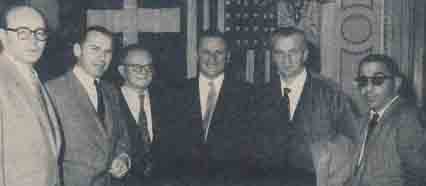Gadsden Times – May 19, 1965
Card reading is the most important single faculty required of the competent declarer. The ability to interpret from the opponents’ bids and plays how their cards are divided is an essential which no good card player can do without. After all, once the location of the opposing 26 cards is known it is not really difficult to achieve the best possible result.

Opening Iead ![]() Q
Q
Take a case like this one. When South gets to four hearts on the bidding shown and West leads a diamond. Declarer takes the diamond with the ace and plays the king of hearts, which East wins with the ace. East returns a diamond to the king and South must now watch his step or he will end up going down one.
Declarer’s best play, without seeing the opponents’ cards, is to enter dummy with a spade, lead a heart, and finesse the nine! If he does this, he makes the contract. If he does not, he is defeated.
I am willing to grant that this finesse has all the ear marks of being based on a look at East’s hand. Ordinarily it would be proper in cash the Q,J of hearts on the reasonable assumption that the hearts are divided 3-2. However, In this case, all signs point to a 4-1 division of the trumps. For this reason, the finesse becomes the indicated play.
Let’s see why this is so. West passed originally, but then reentered the bidding with a double of a heart. At trick two, East showed up with the ace of hearts, leaving 11 high-card points, at most, which West could have had for his vulnerable takeout double.
West could scarcely double with only 11 high-card points unless he had either a void or a singleton in hearts. A hand where West could have the 10 x of hearts and still Justifiably double the heart bid would be extremely rare, if not impossible. On this basis, declarer has every right to assume that a heart finesse, if attempted, will succeed.
